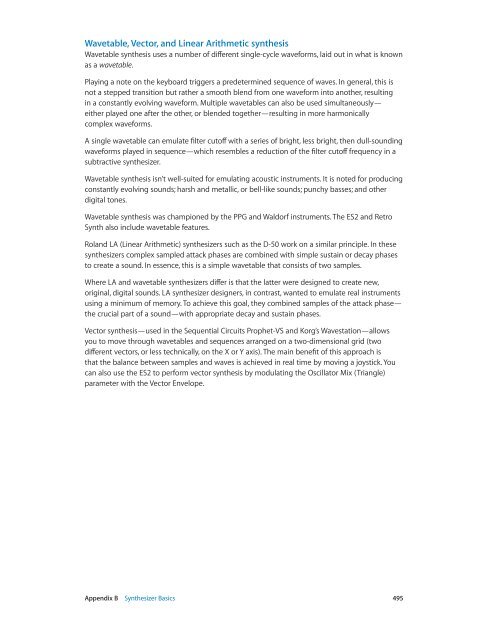Apple MainStage 3 Instruments - MainStage 3 Instruments
Apple MainStage 3 Instruments - MainStage 3 Instruments
Apple MainStage 3 Instruments - MainStage 3 Instruments
Create successful ePaper yourself
Turn your PDF publications into a flip-book with our unique Google optimized e-Paper software.
Wavetable, Vector, and Linear Arithmetic synthesis<br />
Wavetable synthesis uses a number of different single-cycle waveforms, laid out in what is known<br />
as a wavetable.<br />
Playing a note on the keyboard triggers a predetermined sequence of waves. In general, this is<br />
not a stepped transition but rather a smooth blend from one waveform into another, resulting<br />
in a constantly evolving waveform. Multiple wavetables can also be used simultaneously—<br />
either played one after the other, or blended together—resulting in more harmonically<br />
complex waveforms.<br />
A single wavetable can emulate filter cutoff with a series of bright, less bright, then dull-sounding<br />
waveforms played in sequence—which resembles a reduction of the filter cutoff frequency in a<br />
subtractive synthesizer.<br />
Wavetable synthesis isn’t well-suited for emulating acoustic instruments. It is noted for producing<br />
constantly evolving sounds; harsh and metallic, or bell-like sounds; punchy basses; and other<br />
digital tones.<br />
Wavetable synthesis was championed by the PPG and Waldorf instruments. The ES2 and Retro<br />
Synth also include wavetable features.<br />
Roland LA (Linear Arithmetic) synthesizers such as the D-50 work on a similar principle. In these<br />
synthesizers complex sampled attack phases are combined with simple sustain or decay phases<br />
to create a sound. In essence, this is a simple wavetable that consists of two samples.<br />
Where LA and wavetable synthesizers differ is that the latter were designed to create new,<br />
original, digital sounds. LA synthesizer designers, in contrast, wanted to emulate real instruments<br />
using a minimum of memory. To achieve this goal, they combined samples of the attack phase—<br />
the crucial part of a sound—with appropriate decay and sustain phases.<br />
Vector synthesis—used in the Sequential Circuits Prophet-VS and Korg’s Wavestation—allows<br />
you to move through wavetables and sequences arranged on a two-dimensional grid (two<br />
different vectors, or less technically, on the X or Y axis). The main benefit of this approach is<br />
that the balance between samples and waves is achieved in real time by moving a joystick. You<br />
can also use the ES2 to perform vector synthesis by modulating the Oscillator Mix (Triangle)<br />
parameter with the Vector Envelope.<br />
Appendix B Synthesizer Basics 495
















